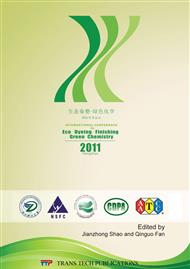p.593
p.598
p.603
p.608
p.613
p.619
p.625
p.631
p.636
The Impact of Liquid Surface Tension on Fabric Drying Efficiency
Abstract:
This study presents an experimental investigation of the relationship between liquid surface tension and fabrics water retention in dehydration processes such as centrifuging, line drying and heat drying. Selected surfactants were used to prepare wash baths with different surface tension, and dehydrating experiments of cotton fabric after immersion in above bath were conducted. The results showed that lower surface tension is beneficial to reducing fabrics water retention by centrifuging and improving line drying efficiency and heat drying efficiency. It was assumed that water with low surface tension is easy to drop down or separate from fabric, thus improving the de-watering and drying efficiency.
Info:
Periodical:
Pages:
613-618
Citation:
Online since:
January 2012
Authors:
Price:
Сopyright:
© 2012 Trans Tech Publications Ltd. All Rights Reserved
Share:
Citation:


